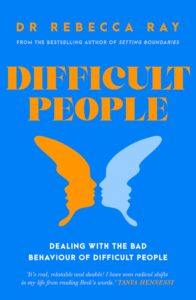 An extract from Difficult People by Rebecca Ray, Macmillan Publishers, RRP $37.99
An extract from Difficult People by Rebecca Ray, Macmillan Publishers, RRP $37.99
Difficult childhoods
Dear reader, you and I had a childhood. We must start here, because we all start here. An adult who had a difficult childhood frequently still holds something from that childhood that continues to hurt in some way. This statement usually elicits a chorus of older generations of parents saying: ‘Well, they turned out fine!’ And I have to ask – did they?
They’re the children that are unsettled in peaceful environments because they were raised in chaos. Their bodies are in perpetual fight/flight mode, seeking out drama because it’s what they know how to navigate. Worse still, they’re so accustomed to abrasive environments that receiving compassion feels not just foreign, but cloying, smothering even. It feels like, if they were to relax into being loved, they’d be risking everything that has kept them safe.
Their psyches are anxious, depressed, traumatised. Their sleep is non-existent, they can’t regulate their emotions, they are reliant on others for validation, and respectful conflict resolution and relationship repair are terms that belong to weird people who know how to say sorry without thinking that person will now hate you forever.
They are difficult people.
A difficult person is not necessarily a ‘bad’ person; sometimes, a difficult person is an emotionally unskilled person, or a person who is in survival mode. A person who is doing what was done to them, and doesn’t know better.
Parenting 101: Creating psychological safety
It is the responsibility of parents and/or primary caregivers to provide a psychologically safe environment for their children. That includes unconditional love (bearing in mind that unconditional love doesn’t mean unconditional tolerance).
Families and relationships of any type are psychologically safe if each person is able to:
- Speak up for their needs and rights freely.
- Be valued for who they are.
- Have their boundaries, needs and rights recognised and honoured.
- Feel comfortable in raising issues that need to be addressed.
- Feel comfortable in working with others in the relationship or family system to solve problems.
- Trust that each person takes responsibility for regulating their feelings and behaviours.
- Trust that each person plays a role in the relationship system that works in alliance with the other person or people.
Families and relationships of any type are psychologically unsafe if:
- Needs are not able to be expressed without fear of attack, dismissal or punishment.
- Rights are disrespected or disregarded.
- Each person is only valued when they acquiesce to someone else’s needs or for what they can do to place the other person in control or at an advantage.
- Raising issues or problems is met with boundary violations such as (but not limited to) gaslighting, humiliation, undermining or blame.
- One person holds power and control over the other(s).
- Self-regulation is absent, with the effects of dysregulation felt by everyone else.
Many parents were never taught what healthy emotional expression, self-regulation and connection with others looks like. No one is perfect before they have a child, and I’m not suggesting that you need to be. The majority of adults who have children plan to love them deeply and give them a better life than they themselves experienced, especially when their own childhood was peppered with unmet needs and resulted in emotional scarring. However, if we fail to hold people responsible for their actions, even when we love them, then we give up our power to heal.
The challenge is that childhood emotional scars don’t just disappear. When someone irrevocably changes their lifestyle and routines by becoming a parent, such a seismic shift can cause the load that they’ve learned to balance, pre-parenthood, to collapse when there’s a little person who suddenly needs much of what they have available to give. And it doesn’t end when they adjust to having a child in their life, because children develop and transition as they grow. Every new developmental phase brings challenges for the parent whose emotional scarring may be triggered by things that happened to them at the same age. A parent can’t necessarily know when a trigger will occur, or stop the switch from being flicked.
Problems occur when parents:
a) Don’t have the psychological mindedness and insight to know that they have emotional scars from their own upbringing, let alone have the awareness of when those scars are triggered;
b) Use ineffective coping strategies when they are in emotional pain, which result in other people (especially their children) weathering the brunt of their pain thanks to emotional dysregulation;
c) Misinterpret the source of the pain as coming from outside themselves, decide that the pain must be from the child in front of them rather than the scars within them, and then punish that child as a result;
d) Decide that if only their child behaved better, then they would parent better, and therefore, their parenting style is the child’s fault;
e) Claim that they are unharmed from their own childhood, and therefore repeat the same authoritarian parenting style that they received on their own child because it’s ‘for their own good’, rather than acknowledging that when we know better, we can do better;
f) Attempt to ‘break the cycle’ for their own child, but wind up going too far in the opposite direction, usually resulting in the creation of a permissive environment that completely lacks boundaried leadership that a child requires to feel safe.
These behaviours imprint on a child to create a pattern that influences all the relationships they go on to experience as an adult. Think of it like a relational template that is unique to the child and their grown-ups that sets the tone for lifelong interpersonal functioning. This template is called an attachment style.
Attachment styles
An attachment style represents the bond between primary caregiver and child, which creates a relational template known as an internal working model for how relationships will go throughout the lifespan. Defined by John Bowlby, it influences a child’s expectations and responses in relationships, based on whether or not their primary caregivers provided a stable, nurturing environment where needs and feelings were met and respected.
Children need a circle of security. Parents are responsible for giving a child the freedom to explore their world with boundaries for safety and learning, while being attentive, interested and supportive during that exploration and offering comfort and protection when the child returns from exploration – think of it as refilling the child’s emotional cup. Providing this circle of security creates a secure attachment for the child.
Our attachment style is intimately connected to our sense of psychological safety in that it is predicated on three fundamental assumptions about ourselves, other people and the world, as identified by Ronnie Jano-Bulman. Children who are raised in an environment where psychological safety and self-regulation are present grow to assume that:
- The world is generally a safe and predictable place.
- They are generally a good person and other people are inherently good.
- Good things generally happen to good people and bad things generally happen to bad people.
Our attachment style shapes how we view ourselves, and the assumptions and expectations we hold about how others see us, too. Parents who fail to meet the needs of their child, or who do so inconsistently, and/or who lead with a heavy hand (or not at all), create an environment that is psychologically unsafe for their child. The experience of a psychologically (and physically) unsafe childhood creates an insecure attachment founded upon violated assumptions of predictability and safety. An insecurely attached individual views the world as no longer safe and predictable, doubts their sense of worthiness and struggles to trust others to have good intentions.
Attachment styles extend beyond childhood and shape how we relate and connect with others as adults. There are four adult attachment styles.
Secure
A secure adult attachment style is characterised by low avoidance of closeness with others and highly positive internal working models of others. Adults who are securely attached generally view others and themselves positively. They are willing to connect and experience low (or no) anxiety in doing so. Securely attached adults believe they are worthy of receiving love and feel safe to offer love to others. They form and maintain relationships and friendships easily and uphold standards for being respected and respecting others, which are supported by healthy boundaries.
The remaining three attachment styles are categorised as insecure.
Preoccupied
A preoccupied attachment style is characterised by a desire for closeness and positive feelings about others coupled with negative feelings about themselves. Someone with a preoccupied style of attachment generally has chronic feelings of anxiety and a deep sense of insecurity, and seeks validation for their worthiness from others. Adults with this attachment style believe that they are not deserving of love from others, while viewing others as more deserving of love than themselves. This pattern often plays out in the form of people-pleasing, where a person is subservient to the needs and wants of others while dismissing the importance of their own needs and desires.
Prioritising others in this way goes beyond the helpful relational skills of nurturance and compromise and tips over into losing their own identity. They pursue worthiness in someone else’s happiness, prioritise other people’s needs over their own, and avoid conflict by being whoever they need to be to ‘not rock the boat’. This is the person who builds their identity around their partner, and the person who consistently responds to questions about their preferences with: ‘What does everyone else want to do?’
Avoidant
This attachment style is characterised by generally feeling okay about oneself (at least, on the surface), but experiencing high levels of avoidance when it comes to closeness with others. An adult with an avoidant attachment style generally believes that they don’t need or desire close relationships. They experience social isolation or superficial relationships as a consequence.
Although the avoidantly attached adult will assure you that’s how they like it – and that may be true on a cognitive level – belonging and connection are non-negotiable needs for all humans. People with an avoidant attachment style often unconsciously believe that allowing themselves to love and be loved is inherently unsafe, so they keep others at arm’s length as a form of interpersonal coping. This is the person who probably says they prefer animals over people and that, ‘being single is better than being hurt’.
Fearful
A fearful attachment style is characterised by high anxiety and high levels of avoidance when it comes to relationships. The fearfully attached adult has a negative view of themselves and of others, which influences their relationships in such a way that they struggle to trust anyone, or to relate in a stable, secure way. They deeply desire closeness, but believe that they are not worthy of love and others cannot be trusted to be a source of safe love. They oscillate between clingy and needy behaviours and hostile and withdrawn behaviours. This creates patterns of push/pull thanks to the eternal collision between needing to be loved and yet feeling unsafe when love and connection are offered.
You might recognise this attachment style around you if someone has been hot and cold: one minute they place you on a pedestal of adoration, and the next minute they devalue and reject you. The change in their emotional temperature is unpredictable from the outside and can be connected to their hypersensitivity. They have learned unworkable ways of having their needs met, which often result in precisely the opposite of what they desire – instead of bringing people closer to them, they eventually push them away.
If part of the load that a difficult person carries is a belief that they are not worthy and/or connection with others is unsafe, setting boundaries becomes an incredibly challenging task. They’ll either leave their gates wide open, permitting anyone unfiltered access to themselves and their resources, or they’ll lock everyone out, guarding their heart and depriving themselves of connection (even though it’s what they desire most) on the assumption that no one can be trusted to love them safely.
Difficult equals disempowered
There is good news, though: attachment style can be changed. It is possible for an insecurely attached adult to develop a healthy relationship with themselves and enjoy loving and healthy relationships with others, even if they don’t start out that way. It takes time and effort, but all change worth making does.
However, this is where we must be mindful of our expectations of difficult people.
Adults who are securely attached are more likely to believe that they have control and agency over their experience in life (internal locus of control). But adults who are insecurely attached, as a result of a lack of psychological safety and/or the experience of trauma in childhood, are more likely to perceive the world through the lens of an external locus of control. That is, they lean towards believing that they don’t have agency in their own lives. They lack the confidence to believe that they can impact their own experiences in the world, a perspective that could be said to predispose them to an unwillingness to participate in behaving differently in their relationships because of an expectation that nothing they do will create a better outcome. It’s thought to be a defence mechanism that grows from a childhood environment that is unsafe and lacking in nurturing. As adults, difficult people then experience a sense of chronic helplessness and powerlessness, along with expectations of abandonment in their relationships, based on what they experienced as children. This translates into insecure adult attachment and a person who gives away their power or takes it from others, feels helpless or makes others feel disempowered, and expects to be abandoned by others or leaves them first before they themselves can be hurt.
What if you have an insecure attachment style?
If you are nodding in recognition so far, I see you and I’m betting you’ve developed a suite of coping responses and survival strategies, some of which you might be able to identify, others that occur automatically, which perhaps you haven’t linked to your past, and all of which speak to the load that you carry, how you love and receive love, and how you relate to others in general.
This doesn’t mean you are a difficult person. Many people have an insecure attachment style as an adult but don’t violate the psychological safety of others or project their emotional dysregulation onto them repeatedly.
Your insecure attachment style doesn’t mean you are broken or that your relationships are doomed. Please go gently on yourself. You have done the best you can with what you’ve had available. Instead of owning your ‘most toxic trait’, consider how it might feel if you held space to see, hear and understand yourself. Instead of ‘calling yourself out on your bullshit’, what would it be like to acknowledge what you’ve been through and connect that to how you had to adapt and the strategies you developed to learn to survive? How would it feel to acknowledge that’s how little you learned to obtain love and get your needs met?
Offer compassion and gratitude to yourself for doing what was necessary to keep you alive. Shaming yourself creates a spiral that can lead to the repetition of cycles that will keep you stuck in a place of survival. Recognition and compassion empowers you to begin unlearning those ways of surviving, in favour of creating a life worth living on your own terms.
You now have valuable information about how you operate in your relationship with yourself and in the relationships you have with others. With this information, you can start becoming psychologically safe for yourself, learn to meet your own needs, and respect your own rights and values as worthy. If you dismiss, ignore or misinterpret your own needs, violate your own rights by having loose or absent boundaries, and devalue your worth as a human by constantly placing unrealistic standards of relational perfection on your shoulders, then you become psychologically unsafe for yourself.
Self-created psychological safety looks like:
- Giving yourself permission to have needs and advocate for them.
- Understanding that you have rights and can advocate for them.
- Knowing you are worthy simply because you exist.
- Identifying, setting and strengthening boundaries so that your needs and rights are recognised and honoured by others.
- Cultivating relationships with other people based on mutual respect and willingness to evolve together.
- Taking responsibility for regulating your feelings and behaviours.
Without the presence of self-created psychological safety, and psychologically safe relationships in your life, it’s much harder to regulate your feelings and behaviours – a skill that’s essential if you desire to live with any sort of inner peace.









Join the Discussion
Type out your comment here:
You must be logged in to post a comment.